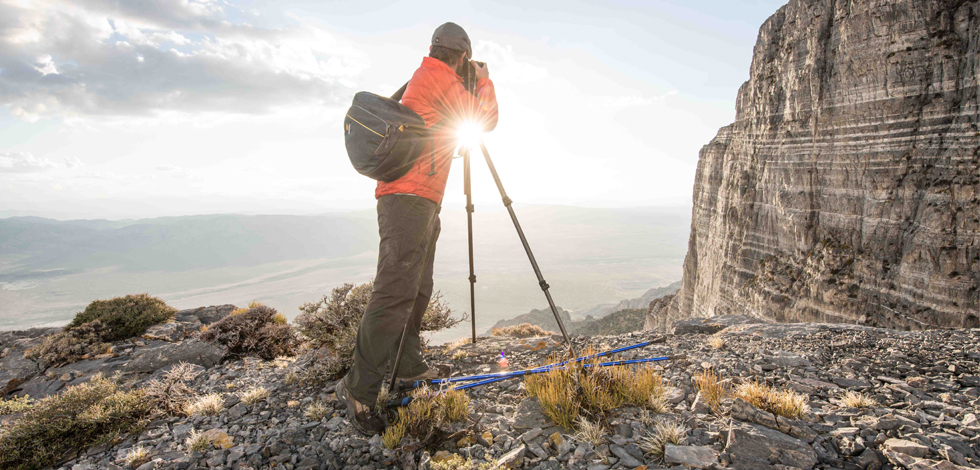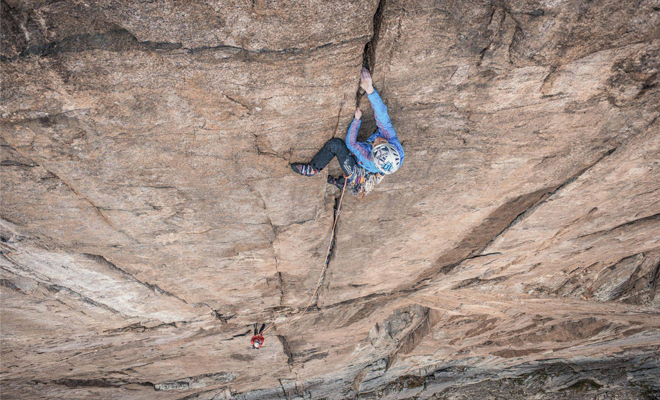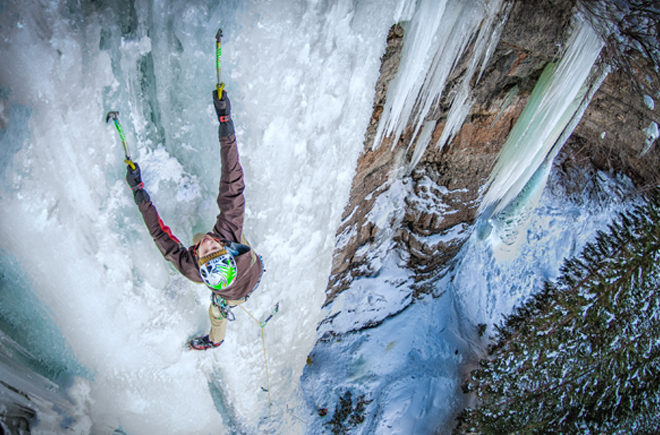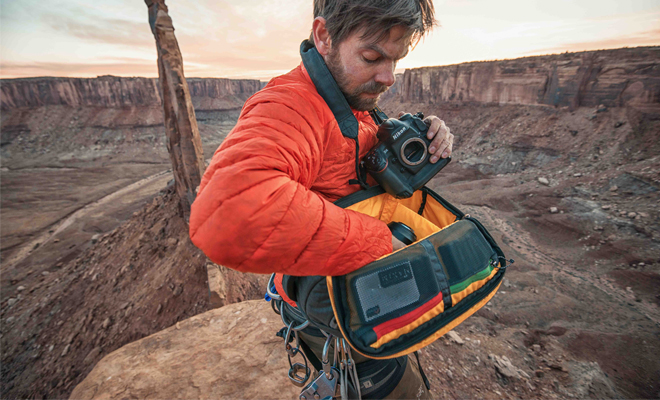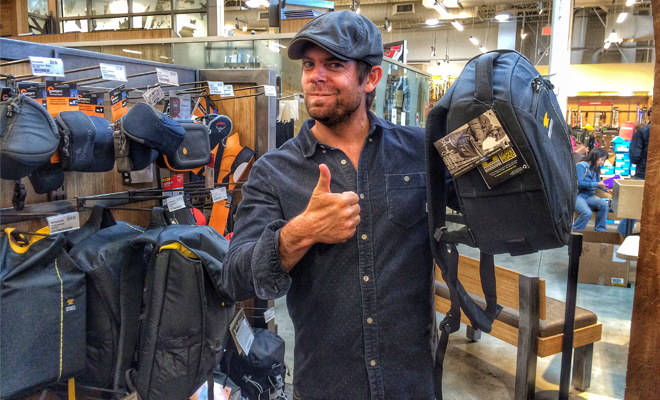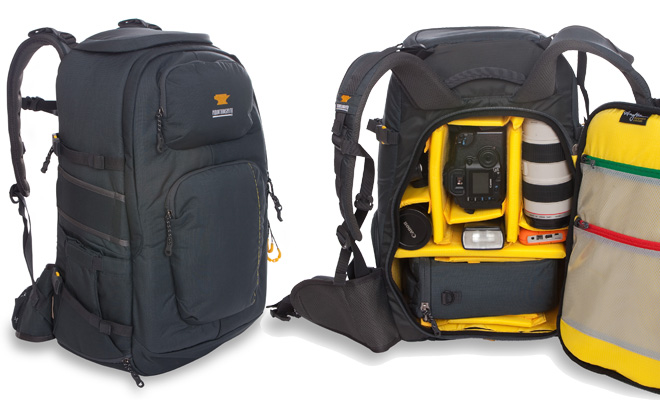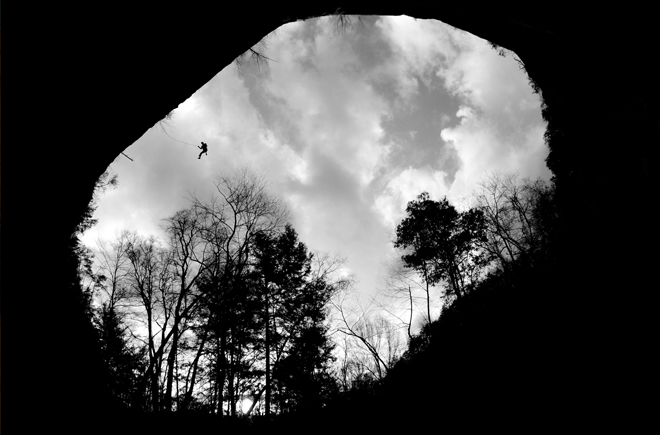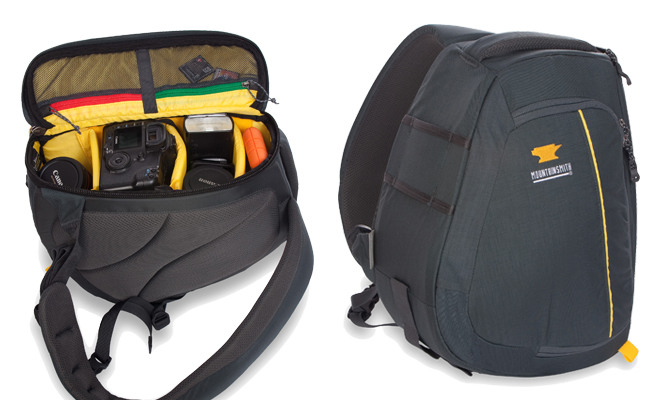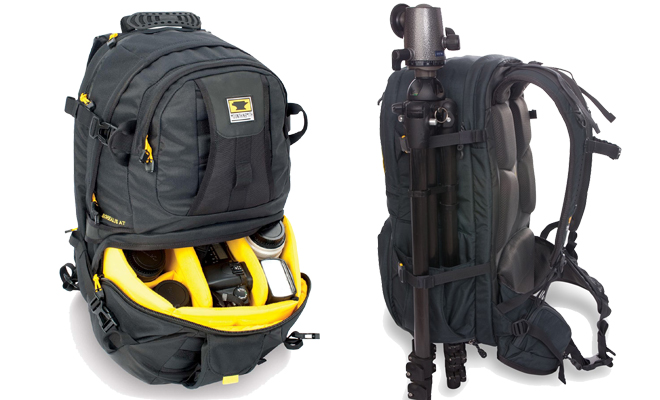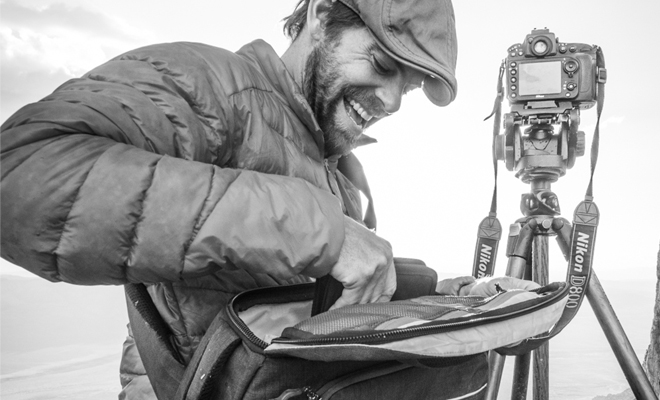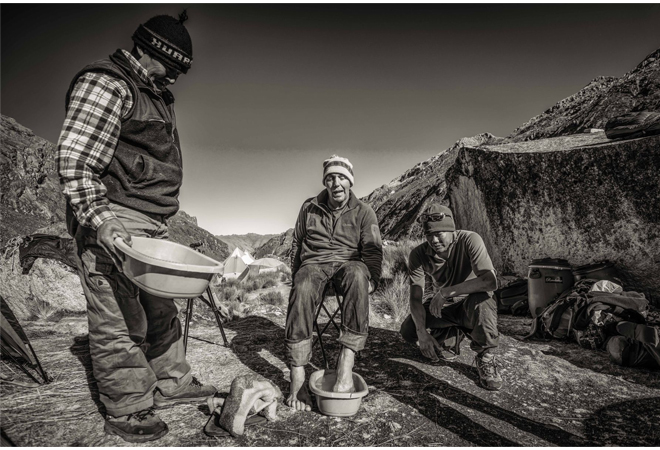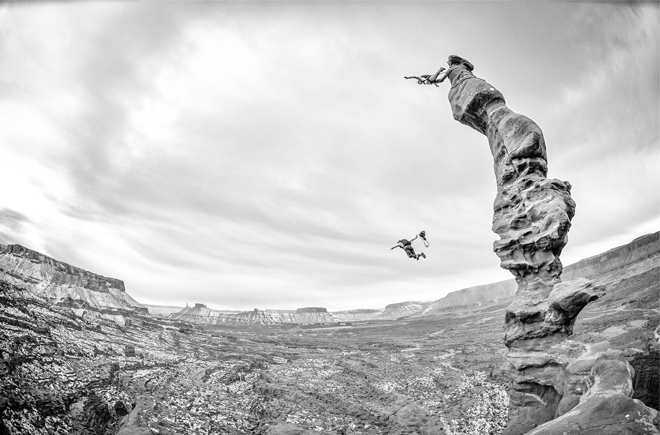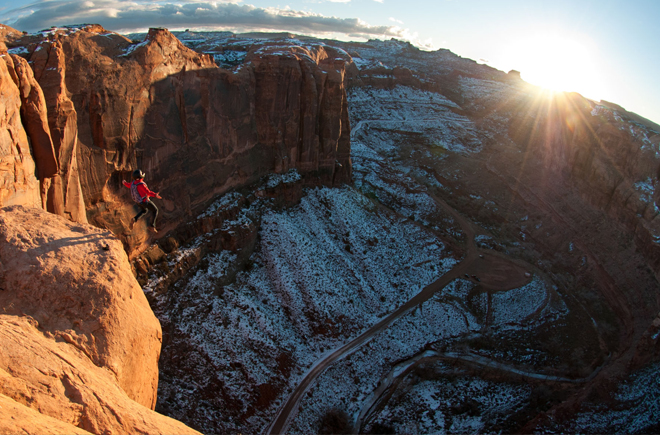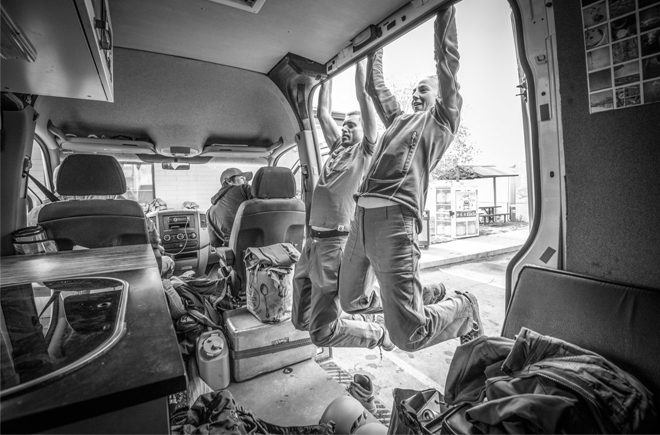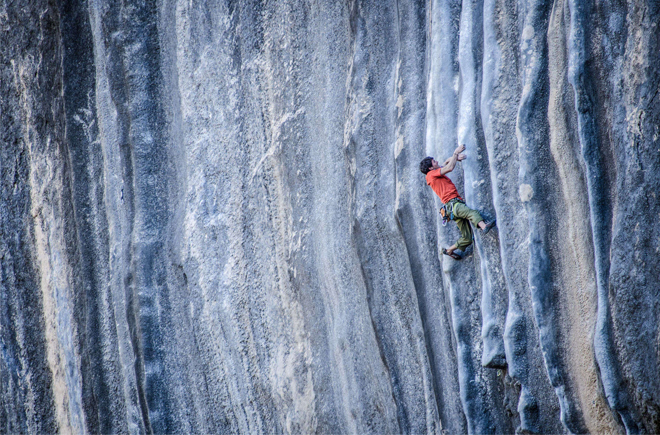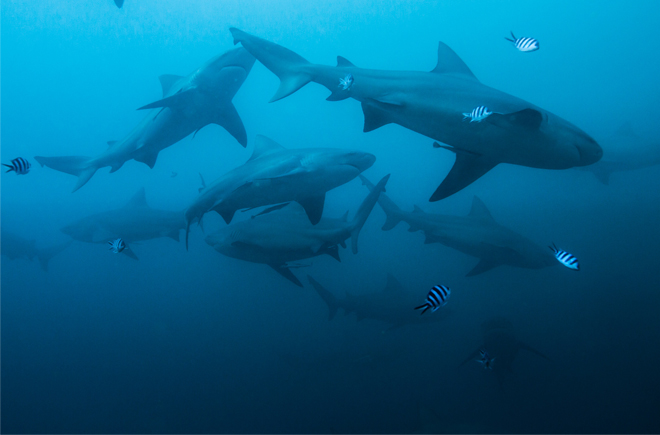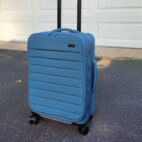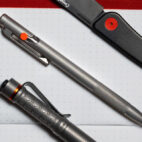Andy Mann Interview :: Adventure Photographer
It’s mid afternoon on rarely climbed Rocky Mountain cliff face. The weather is brisk and spring is in the air. Melting snow rushes down the face and into the river below. The light has that beautiful pre daylight saving glimmer and the climbers are back at it. Having ditched the spikes and snow axes of winter the climbers are eager to cram their fingers and toes into the tiniest of cracks and haul themselves up the fresh line. Above them, dangling by rope and swinging himself into position, camera poised and ready, is photographer Andy Mann.
Andy has that job we all dream of. He journeys to the exotic places in the world that grace the covers of National Geographic and other outdoors magazines. As an adventure photographer he doesn’t have the luxury of the studio or the camera van. He has to bring everything he needs with him out into the field and document the action unfolding in front of his eyes.
To be honest he couldn’t be carrying a worse thing: bags brimming with heavy metal, glass, cameras and associated accessories to try to capture the adventure. His unique approach to what he brings and how he brings it has led him to develop a style where he ‘tags along’ with explorers, climbers and divers around the globe. His imagery is evident of this style, as what he documents is entirely unplanned and unstaged. He is a part of the action, bringing an undeniable amount of authenticity to his visual storytelling.
Contributor and professional photographer, Shelby Craig, managed to speak to Andy a day before he was heading to the Fijian Islands on a shark diving expedition. They talked photography, travel, adventure and his recent collaboration with Mountainsmith…
Give us an insight into your world as an adventure photographer?
My style of photography has become a hybrid of both photo and video, mostly through expedition storytelling. What I do is go out to remote parts of the world, virgin earth places, and go on expeditions with climbers or divers and tag along. I tell the story of explorations, of fear, of joy, of hardships. The things that bring out the grit in human character. The no-way-to-go-but-up situations. I look for the stories.
I also shoot a lot of music. When I listen to a song I try to scratch at the wounds more than most people think.
How did you get involved with Mountainsmith to develop the Parallax Pack?
Well they are a Front Range (Mountains) Colorado small pack company. They’ve been known for years for their core backpacks and lumbar packs. They have that iconic anvil logo that’s well recognised in Colorado. They were only based about a half hour down the road from me and I think we crossed paths at a trade show in Salt Lake City where I was on the road working as a senior contributing photographer for Climbing Magazine.
I was passing through Salt Lake City and I needed a pack that would do a little more than a traditional camera pack because I was hiking up cliffs and all and they had one that I was interested in. I was really looking for handouts. I was strategically hitting them up on the last day of the trade show and knew that companies often gave out gear then. They had this pack the Mountainsmith Borealis and it’s part of their signature line. It had a good support system and you can throw camera stuff in the bottom and it had a big backpack style space at the top where you can throw rope, water and lunch. I told the guys what I did and they agreed to give me one to use as long as when we were all back in Colorado I had a beer and talked about what I thought of the pack as it was still a prototype.
That started a relationship of using their packs in the field and on the road. For several years I would just wear a pack out and they would send me a new one after telling them what worked and what didn’t. We’d go climbing and have beers and talk bags and then at the end of 2012 and beginning of 2014 we sat down and they were like “What would you do differently?” I’d worn these packs out every which way and I immediately started working with the designer changing some things and moving some things around. At the same time my career started to grow and we decided to partner up. And they allowed me to design something for photographers. That’s how it started and now it’s grown into what it is now. A full grown partnership.
Would you say that traditional photo bag makers don’t make bags that are up to scratch for your style of adventure photography?
A lot of the bag manufacturers try to produce something in the middle of the line. There are just a few specific details that I think make a camera bag perform better in the field. It could be as simple as tack loop or a material.
I personally just started adding a few of those things and then stripping the rest of the bag back and starting from scratch really. I feel like people were botching it. Most camera bags just have all these little issues. For example, most camera bags have this little flap that folds down on the front of the bag where the tripod sits in the middle of the bag. With lots of straps, loops and everything. And it’s just like dude, strip all that off and strap it to the side so you can access everything. The bags I designed with Mountainsmith are just really clean because the last thing you want when you’re in the field with a harness on and with ropes around is more straps and buckles etc.
What are some of the details that you find essential for your style of bags?
For my style of bag I think what makes them work best is that the design of the bag recognises that the quiver of gear people take is very different. In that camera bag you need to be able to carry a computer, hard drive, sound equipment, cameras, flashes, light stands, etc. It’s a ton of stuff. It needs to fit in the overhead bin and the fabric needs to make sense; it needs to at least repel water. It needs to be sleek because it needs to be able to fit in a bigger bag without getting snagged.
I feel like getting rid of all the bells and whistles is essential. The straps and buckles. A lack of features is nice actually.
Also, when bags have good heritage. Mountainsmith took their support system called the Anvil Airway and put it into my bags which is great because my loads are heavy. Camera bags get beat up because cameras are heavy. Nothing is light anymore. Especially if you’re lugging Lithium Ion batteries.
Lastly I care about the colour and that the fabric is solid and that it’s waterproof. It’s nice to look at a bag and go ‘you look good’.
You are obviously someone who is always traveling, thus always carrying. What are some challenges you face with all this travel?
Probably packing. First knowing what stuff to bring, then always trying to figure out what bag to bring for which situation. I often want to pack my stuff into lots of smaller bags. Mountainsmith makes these cool little Kit Cubes that are awesome. They are just little roll-top things that can fit in anything.
My favourite bag that is designed specifically for rock climbing shooting is the Descent. That’s my favourite one.
I’ve got three checked bags, a carry-on and I need to make it all work. It’s a puzzle, everything to do with packing.
Getting all the gear there is often hard too, but the guys I roll with are very ‘no excuses’. Their packs are just as heavy as mine, filled with climbing gear and we just deal with it and do it.
What would make traveling with all your gear easier?
I feel like just having the option for space. The Borealis is good for that reason. It’s good for traveling for that reason. It has lots of space at the top and padded compartments for cameras at the bottom. I think the solution is to have options so you have a blank canvas. You just want to get everything in a pack and go. When things are over-slotted and over-designed you have issues. Sometimes you need a big sack. A place to put shit.
Do you have any tips or habits from the road you can share?
I always, always carry my stuff on me. Nothing protects you from lost baggage period. You can build it out of armour and what’s inside will be protected but it still has to get there. If your bag gets lost you’re bummed because it could ruin the job or the expedition because time is always of the essence.
The import thing for me is to be able to travel with everything on your back and know that everything can fit in the overhead. You have to think about where you’re traveling and on what kind of transportation or aircraft. What happens if you get on a small commuter plane and they tell you that they need to check your bag because it doesn’t fit in the overhead? That’s a problem. Your lenses will be fogged up when you get there or something might get crushed. I always carry a smaller bag within my carry-on because you have to be prepared to deal with those situations without a problem. To pull out at least the goods such as the cameras or the hard drives and keep them with you. To be able to divide if needed is so important.
Sometimes having things on your back makes them look smaller, lighter and more compact.
At the end of the job the thing you’re not going to give them ever is the hard drive with the job on it. Even if you need a little lumbar fanny pack. The goods are always important to keep with you.
What does the environment demand from your gear? What are the important things for protecting your camera gear?
First the fabric – waterproof coating and/or a rain cover is essential when outside.
Other than that I don’t overly protect my gear very often. I’m more concerned with protecting myself and getting the shot. I can tell you how many things I’ve wrecked. That’s something I’ve decided early on. I’m just a little different. It’s hard for me to manage everything. I like to focus on the creative side. I just don’t mind beating up my stuff and just dealing with it. I shoot a lot. All year long. In many different environments. The cameras, lens coatings and bags I use are pretty burly. If you can just put your stuff in your bag and zip it up it’s safe. That’s the safety zone, when the equipment is in the bag. When it’s out of the bag there is no safety zone. I just keep myself safe. My equipment is a sacrifice. At some point you just have to go my gear is a soldier and it’s going into battle when it’s out of the bag and when it’s in the bag it’s home and it’s safe.
Do other carry products such as messenger bags, rollers, hard shells, etc have features that give you ideas for photo bags?
I think you can always keep an eye on fabrics. In the outdoor industry where everyone is going lighter, faster, stronger you see that. Recently I decided to go a little more cowboy. I like canvas and denim. I’d like to see bags last longer and show signs of wear. I dig the messenger style bags. There are a few jobs I do every year where I don’t want a backpack and I’ll bring a messenger bag. Like if I’m at a show shooting music I like to have something that I can have over the shoulder that I can open quickly and take a shot and then walk away. They work great for events or music, not so much in the field.
I love the four bags in my range but I’m always looking for ways to make them better.
Things are evolving so quickly with fabrics and style that you have to be thinking forward because that’s what people are looking for.
I would even make them (my bags) more rugged going forward. Canvas and all.
Any nightmare travel stories?
Last July another National Geographic photographer (Corey Richards) and I did an assignment in remote Russia. We had to fly from Saint Petersburg to this arctic Russian town and we had to get our stuff from Saint Petersburg Airport and then re-check it before this domestic flight. We had 20 bags or something and a lot of them were camera gear. Of course one thing didn’t show up for a while and the longer we stood there with our bags the longer we stuck out. An officer then came over and was like, “What do you have? What’s all this stuff? Do you have paperwork for it?” I was like here we go because we didn’t have paperwork. You’re only allowed to bring $10k worth of stuff into Russia and he gave us this form to fill out and we had like multiple $10k cameras. So we had to list item by item with a value massively below what it was worth. Like 1x Nikon 24mm 1.4 lens …$69… like massively undervaluing everything to hope that they just let us go. They just wanted to throw around a bit of power. They gave us a hard time but eventually let us through. And that happens all the time.
You just want to kinda fly under the radar the best you can, you know, but that’s so hard with photo gear..
Now I just bring a spreadsheet with serial numbers of my gear. I don’t put a price on it because if they ask me “Hey are you going to sell this stuff?” I can leave one and say here’s my list of gear and they can compare it when I come back on the way out.
Have you had any issues with lost or stolen gear?
I haven’t surprisingly enough because I have it on my back or right at my feet. I can’t stress the importance of having the goods with you. I’ve lost a few duffels, some climbing stuff. I just try not to take the risk. I’m usually moving through a city pretty quickly and then out into the wilderness where the risk is low for stolen gear.
Have you ever lost a lens or something while on the wall climb?
Oh yeah! I’ve dropped some pocket wizards and some other stuff. Part of the reason why I’ve designed the Descent, which is the slingshot style bag, is because it just floats right in front of your chest. You can open it up right there and you can change stuff inside the actual bag on your chest and you can zip it and sling it back around and be shooting again. Ever since that bag has been out shooting with me on the wall I haven’t lost anything.
What’s your go-to daily bag that you run with around town at home?
Mountainsmith has a computer bag, the Spectrum, that I use to commute with. I’ll carry a computer, some hard drives and it fits a little Sony NEX-7. It’s my around-the-town bag that I use to get to and from my production company.
What’s a day like at home for you in Boulder, Colorado?
Well I have my production company 3 Strings Productions that I founded with Keith Ladzinski and Cory Richards. I usually commute by bike to work, see what’s going on, make sure everyone is working on the right projects, keep everyone motivated and creative. Then it’s kinda an unspoken rule that if the weather’s nice we all go out at lunch to do something active. We have trail runs, bike trails, hikes etc. close by. Then after work I ride my bike home, cook dinner and just really try to stay creative and motivated.
What’s your go-to travel bag not for camera gear?
I travel with duffels. Climbing and haul bag duffels. I travel with them because they are waterproof, you can throw them around. They pack super well. You can strap them onto a roof of a car, to a camel, anywhere really. You can stash them outdoors in the pouring rain. When it comes to travel the important thing to do is to have room. I have my Parallax on my back. That has my computer, my hard drives, all my camera stuff. Then I’ll have these haul bags and they are just full of gear that I need to get on location and to sleep. You can drag duffels.
Can you give me the essential carry kit when traveling the globe (bags, accessories etc.)?
I travel with two of these three camera packs at any given time/trip:
Mountainsmith –
Borealis
Descent
Spectrum
They are all built to carry more than cameras and lenses which is clutch for me on the go. I also travel with my Arc’teryx Arrakis 65 – a waterproof bag that holds my clothes and carries my smaller camera bags along the way into the field.
What single photography moment has given you the biggest smile?
I hold close to me a mountain of memories and laughter, all relate to the crack of the shutter somewhere beautiful. Of all the sunsets and epic adventures, I’d have to say a selfie I took with me and my fiancee when I asked her to marry me in Costa Rica. I still get chills on that one! #SELFIE!!!!
What’s next for Andy Mann?
Continuing to grow as a photographer and find new ways to express myself as an artist. I’m spending a lot of time underwater these days and it’s a whole new world for me. I’d love to take that a step further.
If you weren’t a pro photographer and all-round rad dude, what profession would you be doing now?
I’d be a musician. Solo acoustic and on the road. It’s my plan B!





 Carry Awards
Carry Awards Insights
Insights Liking
Liking Projects
Projects Interviews
Interviews
